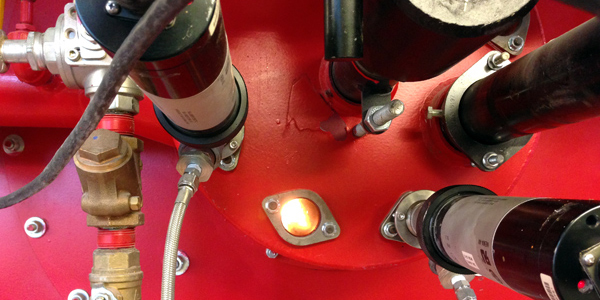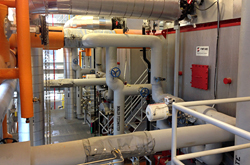Steam Plant Upgrades Save Energy

Energy will be supplied to NC State buildings more reliably and efficiently thanks to the completion of a major boiler upgrade at the Yarbrough Drive Steam Plant, where existing boilers installed as early as 1949 have been replaced. After nearly 18 months of construction, two new 100,000 pound-per-hour boilers are up and running, replacing two 50,000 pound-per-hour boilers. The upgrade will result in a 14 percent jump in efficiency.
“It was definitely an efficiency improvement and enables us to keep up with campus demand. We always want to have more steam capacity on standby than what full campus load would demand. So if we have one boiler down, we’re still able to maintain and provide reliable and cost-efficient steam production to campus,” said Bill Ferrell, a plant engineer at the Yarbrough facility.

The final phase in a $61 million energy performance contract, the Yarbrough upgrades come on top of efficiency increases at the university’s Cates Avenue Steam Plant, where cogeneration technology was added in 2012 to enable the university to capture wasted exhaust heat and convert it to steam. Steam is used as the primary heating source for the majority of buildings on main campus.
In addition to efficiency increases, the new natural gas-powered boilers use No. 2 fuel oil as a backup fuel supply, which burns cleaner and operates more easily than the No. 6 fuel oil used by the old boilers. This alternate fuel supply is used during curtailment periods when suppliers divert limited natural gas supply from NC State in order to meet the demands of other customers.
The renovation also included refurbishing the plant’s last existing boiler and installing new auxiliary equipment throughout the plant, which was built in the 1920s.
“Now the entire system is running more efficiently and is easier to operate,” Ferrell said.
The renovation is expected to earn LEED Silver certification from the U.S. Green Building Council. LEED, short for Leadership in Energy and Environmental Design, recognizes sustainability efforts such as the recycling rate of steel and other demolition debris, efficiency improvements and the use of sustainable building materials.
For tips and more information on what you can do to conserve energy on campus, visit go.ncsu.edu/SaveEnergy.
- Categories:


